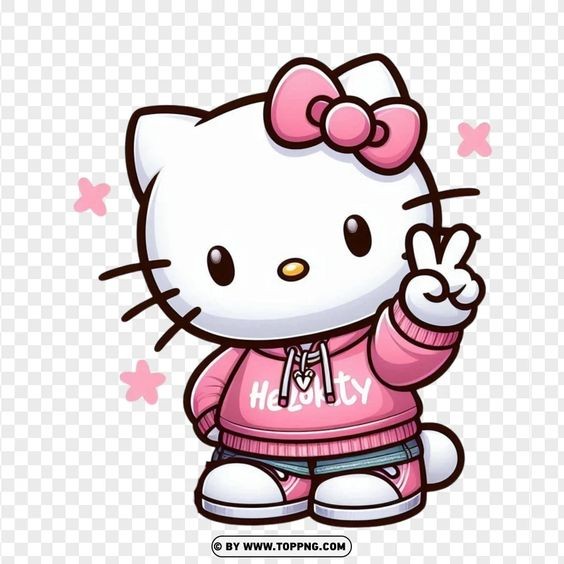The Iconic Hello Kitty Peace Sign: A Cultural Phenomenon
Introduction
Hello Kitty, the adorable white kitten with a red bow, has transcended her origins as a simple character in Japanese pop culture to become a global icon. Created by Yuko Shimizu and introduced by the Sanrio company in 1974, Hello Kitty quickly became a symbol of "kawaii" (cute) culture in Japan. Over the decades, her image has been associated with a wide range of products, from toys and fashion accessories to home decor and even airplanes. However, one of the most recognizable and enduring gestures associated with Hello Kitty is her iconic peace sign. This simple hand gesture, where she holds up two fingers in a V-shape, has become a significant cultural symbol, embodying themes of peace, happiness, and universal love.
The Origins of the Peace Sign in Japan
To understand the significance of the Hello Kitty peace sign, it's essential to explore the origins of the peace sign gesture in Japanese culture. The V-sign, with the palm facing outward and the index and middle fingers raised, is known as the "peace sign" in many Western cultures. However, in Japan, it carries a broader meaning. The V-sign became popular in Japan after World War II, particularly in the 1970s, when it was adopted as a symbol of happiness, victory, and positivity.
Its popularity surged thanks to Japanese celebrities and athletes who used the gesture in public appearances, further embedding it into the cultural fabric. The gesture was not limited to political or social contexts; it became a staple in photography, especially among young people. Whether posing for a casual snapshot or a professional photo, the peace sign became a go-to gesture, symbolizing a carefree and joyful attitude.
Hello Kitty and the Peace Sign: A Perfect Match
Hello Kitty, with her round face, simple design, and lack of a mouth (intended to allow people to project their own emotions onto her), was already a symbol of innocence and positivity. When she was depicted making the peace sign, the gesture resonated with fans, reinforcing her image as a character embodying kindness, love, and universal happiness.
The peace sign gesture aligned perfectly with Hello Kitty’s brand identity. It added a dynamic element to her otherwise static poses and gave fans a way to connect with her on a personal level. By mimicking the peace sign, fans could emulate Hello Kitty's positive and peaceful attitude. This gesture, therefore, became more than just a pose; it became a way for fans to express their admiration for Hello Kitty and her values.
The Global Spread of the Hello Kitty Peace Sign
As Hello Kitty’s popularity spread beyond Japan, so did the peace sign gesture associated with her. In the 1980s and 1990s, Hello Kitty became a global phenomenon, with merchandise available in stores worldwide. The peace sign, already popular in Japan, began to be recognized internationally as part of Hello Kitty’s imagery.
In the United States and Europe, the peace sign had different connotations, often associated with the 1960s counterculture and the anti-war movement. However, when paired with Hello Kitty, the gesture took on a more universal and apolitical meaning. It became a symbol of unity, positivity, and the simple joys of life, much like the character herself. Hello Kitty’s peace sign was embraced by people of all ages, transcending cultural and linguistic barriers.
The Hello Kitty Peace Sign in Pop Culture and Fashion
Hello Kitty’s influence in fashion and pop culture is undeniable. The peace sign has been featured on countless Hello Kitty products, from clothing and accessories to stationery and digital stickers. Celebrities, including popular musicians and fashion icons, have been seen sporting Hello Kitty gear, often incorporating the peace sign into their style. This trend has helped solidify the peace sign as an integral part of Hello Kitty’s brand.
In addition to physical products, the Hello Kitty peace sign has made appearances in various media, including television shows, music videos, and social media. Fans often post photos of themselves imitating the peace sign, sometimes with Hello Kitty accessories or clothing, creating a global community of Hello Kitty enthusiasts who share a common symbol of positivity and peace.
Cultural Impact and Legacy
The enduring popularity of the Hello Kitty peace sign speaks to the broader cultural impact of the character herself. Hello Kitty represents more than just a cute character; she embodies values that resonate universally—kindness, friendship, and peace. The peace sign is a visual representation of these values, making it a powerful symbol in its own right.
In a world often marked by division and conflict, the simplicity and innocence of Hello Kitty’s peace sign offer a reminder of the power of positivity and the importance of maintaining a joyful outlook on life. This gesture has become a way for people around the world to express these values, regardless of their background or nationality.
Conclusion
The Hello Kitty peace sign is more than just a cute pose; it’s a cultural phenomenon that has transcended its origins to become a global symbol of peace and positivity. Rooted in Japanese culture, the peace sign has been embraced by Hello Kitty fans worldwide, who see it as a reflection of the character’s values. Whether in fashion, pop culture, or everyday life, the Hello Kitty peace sign continues to inspire and bring joy to millions, proving that sometimes the simplest gestures can have the most profound impact.






